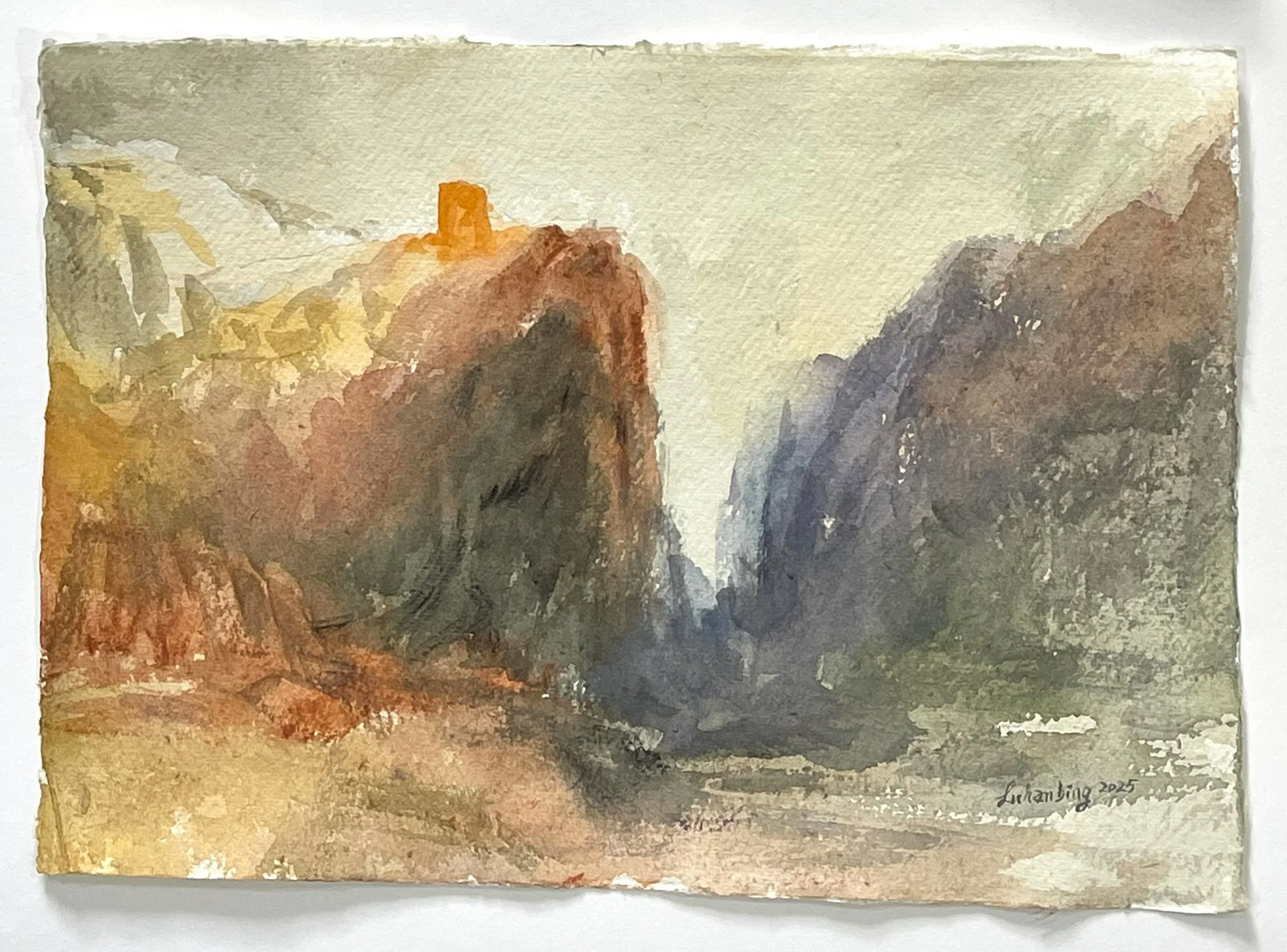Hello, Mr. Turner
Last year, during my first visit back to Shanghai in five years, I had the rare opportunity to see Turner’s original works at the Museum of Art Pudong. The exhibition, Dialogues with Turner: Evoking the Sublime, was co‑organised by the Museum of Art Pudong (MAP) and the Tate in London, showcasing over 100 works, including about 80 original oil paintings and watercolours by J.M.W. Turner—many of which were being displayed in China for the very first time. Turner’s evocative use of light and color, his visionary landscapes that seem to merge atmosphere and emotion, left me awestruck.
Moved by this encounter, I decided to create my own copy of one of the watercolours I saw. I spent a long time studying the image, imagining the conditions in which Turner painted—the light, the landscape, and the emotional landscape behind each stroke. This experience deepened my curiosity about Turner’s technique and legacy. His skill in capturing the sublime—a feeling of awe mingled with nature’s power—resonates not only in my memory, but now, through my own hand, on paper.
Joseph Mallord Willim Turner, Nant Peris, looking towards Snowdon (?Nant Ffrancon from Llanllechyd)
c. 1799 - 1800, graphite and watercolour on paper.
The image I chose was Nant Peris, looking towards Snowdon. Below is the text from the museum didactic:
“This astonishingly ambitious watercolour is one of several large sheets Turner produced during his 1799 tour of Snowdonia in North Wales. The year before, he had travelled to the same area, which includes Snowdon, Wales’s highest mountain at 1,085 metres, and gained inspiration for the second of his two tours. On this journey, Turner carried with him his usual sketchbooks as well as several large sheets of folded watercolour paper, producing substantial works directly on site.
Although outdoor watercolours of this scale are rare in Turner’s practice, here he made a bold attempt to capture the grandeur of the mountains and scenery directly. This sheet shows a dramatic mountain view, with clouds breaking apart to reveal shafts of sunlight. From the centre, a stream zigzags downwards like a ribbon, reinforcing the viewer’s sense of distance. The view may represent Llyn Peris, near Llanberis, with Dolbadarn Castle perched on the hill to the left of the lake.
Although Turner rarely finished such ambitious watercolours entirely on site, he may have added to this one either back in his studio or later in life. He also referred to this study when creating a pencil sketch of the same view for his series Picturesque Views in England and Wales.”
To copy this piece, the first consideration was which paper to use. Khadi paper with deckle edges felt like a good choice to echo the vintage quality of Turner’s work. Next, I did a small colour trial to test the palette. Most of the colours came from my unwashed watercolour palette. For the first wash, I laid down the lightest tones of the painting and enjoyed how the rough texture of the Khadi paper interacted with the pigments. This stage was also a test of the paper itself, allowing me to see its effects with open-ended expectations.
The most difficult part was rendering the foreground details. I found that the paper worked best for the initial wash, but subsequent brushwork felt rigid and less fluid. The overall colour harmony in my copy is cooler than in the original image. While I am pleased with the treatment of the clouds and mountains, I feel less satisfied with the handling of the foreground.
Hanbing Lu, Study after J.M.W. Turner, Nant Peris, Looking Towards Snowdon
2025, watercolour on A4 320gsm Khadi paper
The other painting I copied from Turner is A Tower in the Val de la Mauienne (or the Via Mala). I began with broad washes to build the atmosphere, then slowly added details to show the tower and the rocky landscape around it. While working, I imagined Turner standing in the valley, sketching quickly as the light changed and the clouds moved. It was a good way to learn both his technique and his feeling for nature. Again, I found that Khadi paper is not suitable for multiple washes, but I really love its natural deckle edges and rough texture.
Joseph Mallord Willim Turner, A Tower in the Val de la Mauienne (or the Via Mala) c. 1836, watercolour and gouache on paper
Hanbing Lu, Study after J.M.W. Turner, A Tower in the Val de la Mauienne (or the Via Mala)
2025, watercolour on A4 320gsm Khadi pape
After completing these two studies of Turner’s masterpieces, I watched the movie Mr. Turner. It gave me a vivid glimpse into Turner’s life—his unkempt personality, his carefree working methods, and his often awkward social interactions. I discovered a real human being full of quirks and contradictions, not just a cold, distant name in an art history book. Finally, I want to say that you can never fully appreciate the greatness of a master’s artistry until you try to copy their work with your own hand.
Hanbing
21 August, 2025



